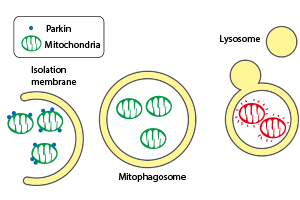Mitochondrial death: mitophagy
Posted on June 12, 2019 at 9:00 PM
Mitophagy is the selective degradation of mitochondria by autophagy, or “self-eating.” It often happens to defective mitochondria following damage or stress. Mitophagy is key to keeping cells healthy. You can think of this as cleaning house, of getting rid of the old and lazy cells that hangout and don’t work. Why not recycle the good parts into new cells. The body must have a way to know when cells are no longer working hard for you. They do! And then, the self-eating begins.!!
Mitophagy promotes mitochondrial turnover and prevents the accumulation of dysfunctional mitochondria, which can lead to cellular degeneration. In addition to the selective removal of damaged mitochondria, mitophagy is also required for adjusting the number of mitochondria depending on cellular needs and during certain cellular developmental stages, such as during the differentiation of red blood cells.
Genetic Eve can help assist you in understanding your Haplogroup and it’s associated risks and providing ideas on protection. Your Family Tree reveals information about your ancestor’s DNA, In particular, your maternal genetics gathered through genetic testing provides valuable information about your mitochondria.
For the Scientist: Because of the danger of having damaged mitochondria in cells, the timely elimination of damaged and aged mitochondria is essential for maintaining cellular integrity. This turnover process consists of sequestration and hydrolytic degradation by lysosomes in a process known as mitophagy.
There are several pathways by which mitophagy is induced in mammalian cells. The PINK1 and Parkin pathway is the best characterized to date. This pathway starts with selecting out damaged mitochondria. The protein PTEN-induced kinase 1 (PINK1) is thought to determine mitochondrial quality.
The abundance of the kinase PINK1 is constitutively repressed in healthy mitochondria by import into the inner mitochondrial membrane and degradation by the protease PARL. When a mitochondrion becomes uncoupled, protein import to the inner mitochondrial membrane is prevented, so PINK1 is diverted from PARL and accumulates on the outer mitochondrial membrane. This accumulated PINK1 acts as a sensor of mitochondrial damage that can flag an individually impaired mitochondrion among a pool of healthy ones. PINK1 on a damaged mitochondrion, through its kinase activity, recruits the E3 ligase Parkin from the cytosol specifically to that impaired mitochondrion. Once there, Parkin ubiquitinates outer mitochondrial membrane proteins and induces autophagic elimination of the flagged mitochondrion. This molecular pathway, along with mitochondrial fission, allows for mitochondrial quality control.


Image References:
Other Mitochondria Links:
- Mitochondria: Reactive oxygen species
- Mitochondria and Immune
- Mitochondria and Aging
- Mitochondrial Bioenergetics
- Mitochondrial involvement in cell death
- Mitochondrial fission/fusion
- Mitochondrial Function
- Mitochondria: Heat
- Mitochondrial Heteroplasmy
- History of Mitochondria
- Mitochondrial vs. Nuclear DNA
- Mitochondrial Oxidative Phosphorylation
- Mitochondrial death: mitophagy
- Mitochondrial diseases
- Mitochondrial Requirements
- Mitochondrial and Toxins